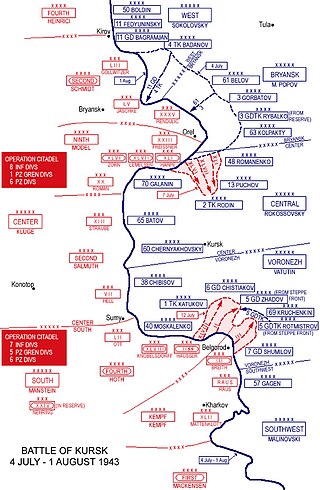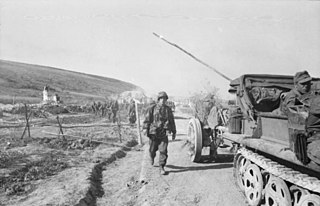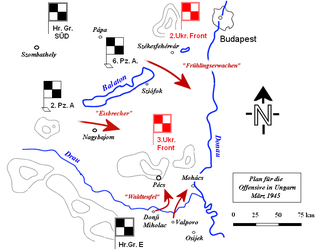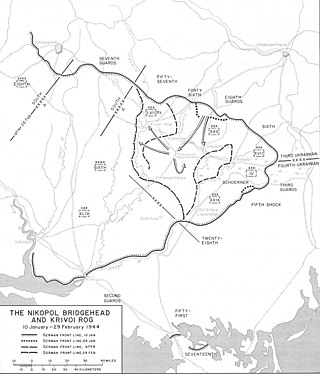
The Battle of Kursk was a major World War II Eastern Front battle between the forces of Germany and the Soviet Union near Kursk in southwestern Russia during the summer of 1943; it ultimately became the largest tank battle in history and resulted in a Soviet victory. It, along with the Battle of Stalingrad several months earlier, are the two most oft-cited turning points in the European theatre of the war preceding the total Allied victory two years later.

Operation Citadel was the German offensive operation in July 1943 against Soviet forces in the Kursk salient, proposed by Generalfeldmarschall Fritz Erich Georg Eduard von Manstein during the Second World War on the Eastern Front that initiated the Battle of Kursk. The deliberate defensive operation that the Soviets implemented to repel the German offensive is referred to as the Kursk Strategic Defensive Operation. The German offensive was countered by two Soviet counter-offensives, Operation Polkovodets Rumyantsev and Operation Kutuzov. For the Germans, the battle was the final strategic offensive that they were able to launch on the Eastern Front. As the Allied invasion of Sicily began, Adolf Hitler was forced to divert troops training in France to meet the Allied threats in the Mediterranean, rather than use them as a strategic reserve for the Eastern Front. Germany's extensive loss of men and tanks ensured that the victorious Soviet Red Army enjoyed the strategic initiative for the remainder of the war.

The Battle of Korsun–Cherkassy, or the battle of the Korsun–Cherkasy pocket, was a World War II battle fought from 24 January to 16 February 1944 in the course of the Soviet Dnieper–Carpathian offensive in Ukraine following the Korsun–Shevchenkovsky offensive.

Operation Spring Awakening was the last major German offensive of World War II. The operation was referred to in Germany as the Plattensee Offensive and in the Soviet Union as the Balaton Defensive Operation. It took place in Western Hungary on the Eastern Front and lasted from 6 March until 15 March, 1945. The objective was to secure the last significant oil reserves still available to the European Axis powers and prevent the Red Army from advancing towards Vienna. The Germans failed in their objectives.

The Prague offensive was the last major military operation of World War II in Europe. The offensive was fought on the Eastern Front from 6 May to 11 May 1945. Fought concurrently with the Prague uprising, the offensive significantly helped the liberation of Czechoslovakia in 1945. The offensive was one of the last engagements of World War II in Europe and continued after Nazi Germany's unconditional capitulation on 8/9 May.

The Lvov–Sandomierz offensive or Lvov–Sandomierz strategic offensive operation was a major Red Army operation to force the German troops from Ukraine and Eastern Poland. Launched in mid-July 1944, the operation was successfully completed by the end of August.
The IV SS Panzer Corps was a panzer corps of the Waffen-SS which saw action on the Eastern Front and in the Balkans during World War II.

The Battle of Debrecen, called by the Red Army the Debrecen Offensive Operation, was a battle taking place from 6 to 29 October 1944 on the Eastern Front in Hungary during World War II.
The II SS Panzer Corps was a German Waffen-SS armoured corps which saw action on both the Eastern and Western Fronts during World War II. It was commanded by Paul Hausser during the Third Battle of Kharkov and the Battle of Kursk in 1943 and by Wilhelm Bittrich on the Western Front in 1944.

The Battle of Radzymin was one of a series of engagements between the 1st Byelorussian Front of the Red Army and the Army Group Centre of the German Army. The battle was part of the Lublin-Brest Offensive between 1 and 4 August 1944 at the conclusion of Operation Bagration the Belorussian strategic offensive operation near the town of Radzymin in the vicinity of Warsaw, part of which entailed a large tank battle at Wołomin. It was the largest tank battle on the territories of Poland during the war.

The Second Battle of Kiev was a part of a much wider Soviet offensive in Ukraine known as the Battle of the Dnieper involving three strategic operations by the Soviet Red Army and one operational counterattack by the Wehrmacht, which took place between 3 November and 22 December 1943.

The Battle of the Transdanubian Hills was a defensive operation of the Bulgarian First Army during Bulgaria's participation in World War II against German Wehrmacht forces, who were trying to capture the north bank of the Drava river as part of Operation Spring Awakening.

The Belgorod–Kharkov strategic offensive operation, or simply Belgorod–Kharkov offensive operation, was a Soviet strategic summer offensive that aimed to recapture Belgorod and Kharkov, and destroy Nazi German forces of the 4th Panzer Army and Army Detachment Kempf. The operation was codenamed Operation Polkovodets Rumyantsev, after the 18th-century Field Marshal Peter Rumyantsev and was conducted by the Voronezh and Steppe Fronts in the southern sector of the Kursk Bulge. The battle was referred to as the Fourth Battle of Kharkov by the Germans.

The Nikopol–Krivoi Rog offensive was an offensive by the Red Army's 3rd Ukrainian Front and elements of the 4th Ukrainian Front against the German 6th Army in the area of Nikopol and Krivoi Rog in Dnipropetrovsk Oblast in central Ukraine between 30 January and 29 February 1944. It took place on the Eastern Front of World War II and was part of the wider Dnieper–Carpathian offensive, a Soviet attack against Army Group South to retake the rest of Ukraine that fell to Germany in 1941.

The 4th Guards Rifle Division was reformed as an elite infantry division on September 18, 1941, from the 1st formation of the 161st Rifle Division as one of the original Guards formations of the Red Army, in recognition of that division's participation in the successful counter-offensive that drove German forces out of their positions at Yelnya. The division then moved northwards to serve in the defense of Leningrad, as well as the early attempts to break that city's siege, but later was redeployed to the southern sector of the front as the crisis around Stalingrad developed. The 4th Guards took part in Operation Uranus which surrounded the German 6th Army in and around that city and then in the pursuit operations that drove the remaining German forces from the Caucasus steppes and the city of Rostov. The division remained in this sector for the duration of the war, fighting through the south of Ukraine through the summer of 1943 and winning the Order of the Red Banner in the process; it was further distinguished with the award of a battle honor in February, 1944. During April and May its advance was halted during the battles along the Dniestr River, but resumed in the August offensive that carried it and its 31st Guards Rifle Corps into the Balkans. It served extensively in the fighting through Hungary and in the outer encirclement during the siege of Budapest in the winter of 1944/45 and in mid-April was awarded a second battle honor for its part in the capture of Vienna. Despite this distinguished service the division was disbanded in 1946.

Operation Konrad III was a German military offensive on the Eastern Front of the Second World War. It was the third and most ambitious of the three Konrad Operations and had the objective of relieving the siege of Budapest and recapturing the entire Transdanubia region. Achieving complete surprise, the German offensive began on 18 January 1945. Supported by the Luftwaffe, the IV SS Panzer Corps, the principal German attack formation, overran the Soviet 4th Guards Army in two days, destroying hundreds of Soviet tanks along the way, reached the Danube river on 19 January and recaptured 400 square kilometers of territory in four days. After nine days of combat, and the destruction by the SS of two-thirds of Soviet tanks in the entire 3rd Ukrainian Front, the German offensive was stopped by Soviet reinforcements 25 kilometers short of Budapest on 26 January.
The 41st Guards Rifle Division was formed as an elite infantry division of the Red Army in August 1942, based on the 1st formation of the 10th Airborne Corps, and served in that role until after the end of the Great Patriotic War. It was the last of a series of ten Guards rifle divisions formed from airborne corps during the spring and summer of 1942. It was briefly assigned to the 1st Guards Army in Stalingrad Front, then to the 24th Army in Don Front, and suffered heavy casualties north of Stalingrad before being withdrawn to the Reserve of the Supreme High Command for a substantial rebuilding. Returning to 1st Guards Army in Southwestern Front in November it took part in Operation Little Saturn as part of 4th Guards Rifle Corps and then advanced into the Donbas where it was caught up in the German counteroffensive in the spring of 1943. During the summer and fall the division fought its way through eastern Ukraine as part of the 6th, and later the 57th Army under several corps commands. It would remain in the southern part of the front for the duration of the war. By February 1944 it was in the 7th Guards Army and took part in the battle for the Korsun Pocket, winning its first battle honor in the process. Shortly after it was transferred to the 4th Guards Army, where it would remain for the duration, still moving through several corps headquarters. The 41st Guards saw limited service in the first Jassy-Kishinev offensive in the spring, but considerably more in August's second offensive and several of its subunits received battle honors or decorations. The division itself won a second honorific during the offensive into Hungary in January 1945 and was later decorated for its role in the capture of Budapest. After the fall of Vienna in April it did garrison duty in the city for a short time before being directed west into lower Austria where it linked up with U.S. forces in the last days of the war. In October, while still in Austria, it was converted to the 18th Guards Mechanized Division.
The 61st Guards Rifle Division was formed as an elite infantry division of the Red Army in January, 1943, based on the 2nd formation of the 159th Rifle Division, and served in that role until after the end of the Great Patriotic War.
The 69th Guards Rifle Division was reformed as an elite infantry division of the Red Army in February 1943, based on the 2nd formation of the 120th Rifle Division, and served in that role until after the end of the Great Patriotic War.
The 95th Guards Rifle Division was reformed as an elite infantry division of the Red Army in May 1943, based on the 1st formation of the 226th Rifle Division, and served in that role until well after the end of the Great Patriotic War. It ended the war on the approaches to Prague and continued to serve well into the postwar era in the Central Group of Forces.

















